You’ll find that starting a garden doesn’t require years of experience or a mystical green thumb. These 15 flowering plants have earned their reputation as beginner-friendly options, thriving with basic care and minimal fuss. From the bold African Marigolds that bloom for months to the drought-resistant Echinacea that attracts butterflies, each plant offers unique benefits while fitting seamlessly into any garden space. Let’s explore how these resilient beauties can transform your outdoor area.
Contents
1. African Marigolds

African Marigolds are known for their distinctive spicy, pungent fragrance and large, showy blooms that can reach up to 5 inches in diameter. These sturdy annuals produce densely packed petals in vibrant shades of yellow, orange, and gold, growing up to 3 feet tall. Their strong scent serves as a natural pest deterrent, making them excellent companion plants in vegetable gardens while also adding dramatic color to borders and containers.
- Light: Full sun, at least 6-8 hours daily
- Water: Moderate watering; allow soil to dry slightly between waterings
- Soil: Well-draining, moderately fertile soil with pH 6.0-7.0
- Temperature: 70-75°F (21-24°C) for ideal growth
- Spacing: 8-12 inches between plants
- Fertilizer: Light feeding monthly with balanced fertilizer
- Planting Time: After last frost in spring
2. Zinnias
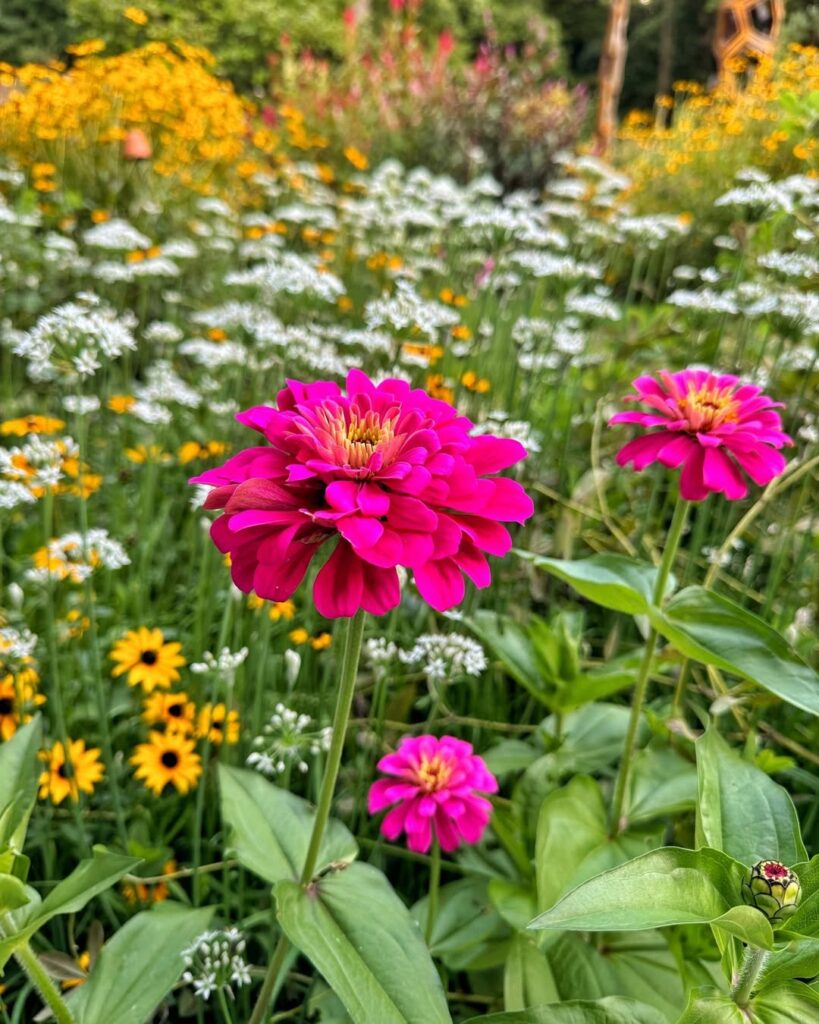
Zinnias are cheerful annual flowers that produce bold, colorful blooms in various shapes and sizes throughout summer and fall. These easy-to-grow flowers come in nearly every color except blue, with single or double-petaled varieties ranging from dwarf types reaching just 6 inches to towering 4-foot specimens. Their long stems and long-lasting blooms make them excellent cut flowers, while their nectar-rich flowers attract butterflies, bees, and hummingbirds to the garden.
- Light: Full sun, at least 6-8 hours daily
- Water: Moderate watering; soil should be kept consistently moist but not waterlogged
- Soil: Well-draining, fertile soil with pH between 5.5 and 7.5
- Temperature: Warm conditions, 74-84°F (23-29°C)
- Spacing: 6-24 inches apart, depending on variety
- Fertilizer: Light feeding with balanced fertilizer during growing season
- Planting time: After all danger of frost has passed in spring
- Deadheading: Regular removal of spent blooms encourages continuous flowering
3. Cosmos
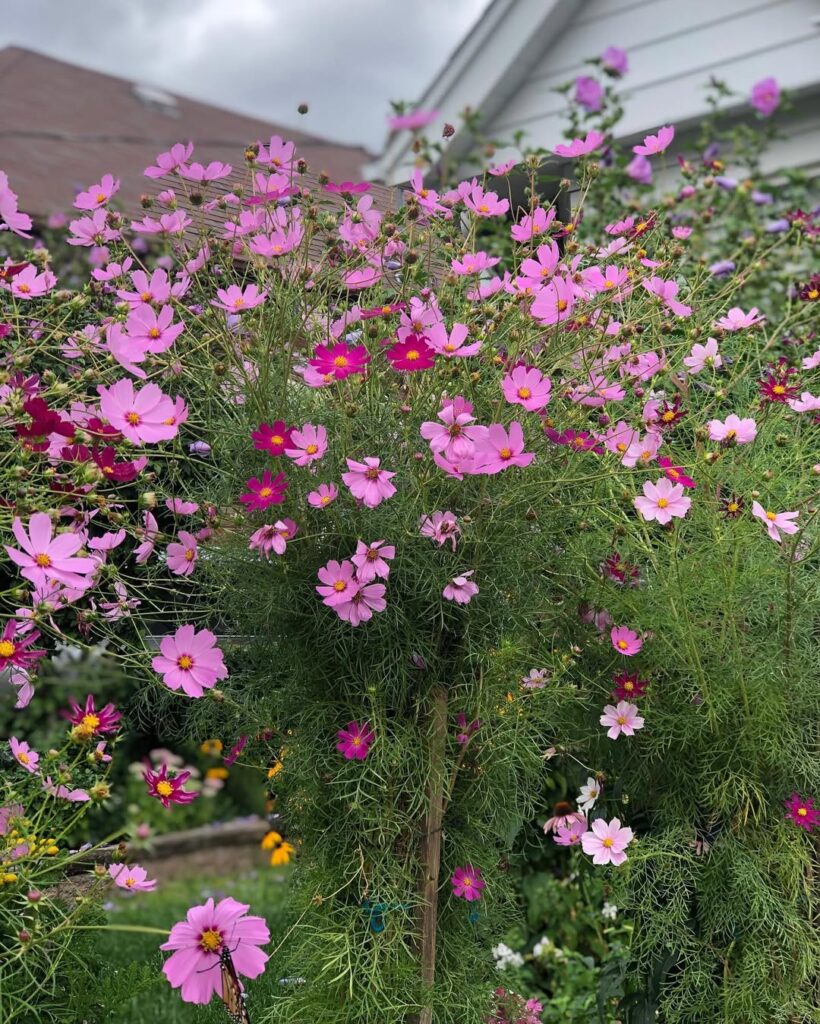
Cosmos are popular annual flowers that live up to their reputation as fast-growing, low-maintenance plants. These daisy-like blooms reach maturity within 7 weeks of planting and continue flowering until frost, producing abundant pink, white, orange, yellow, or red blossoms on tall stems that can grow 2-5 feet high. Their feathery foliage adds texture to gardens, and they make excellent cut flowers while attracting pollinators like butterflies and bees.
- Light: Full sun (6-8 hours daily)
- Water: Moderate watering; drought-tolerant once established
- Soil: Well-draining, average to poor soil; tolerates sandy conditions
- pH: 6.0-7.0
- Temperature: 65-75°F (18-24°C)
- Spacing: 12-18 inches between plants
- Fertilizer: Light feeding; too much nitrogen reduces blooming
- Planting Time: Spring, after last frost
- Planting Depth: 1/4 inch deep
4. Petunia
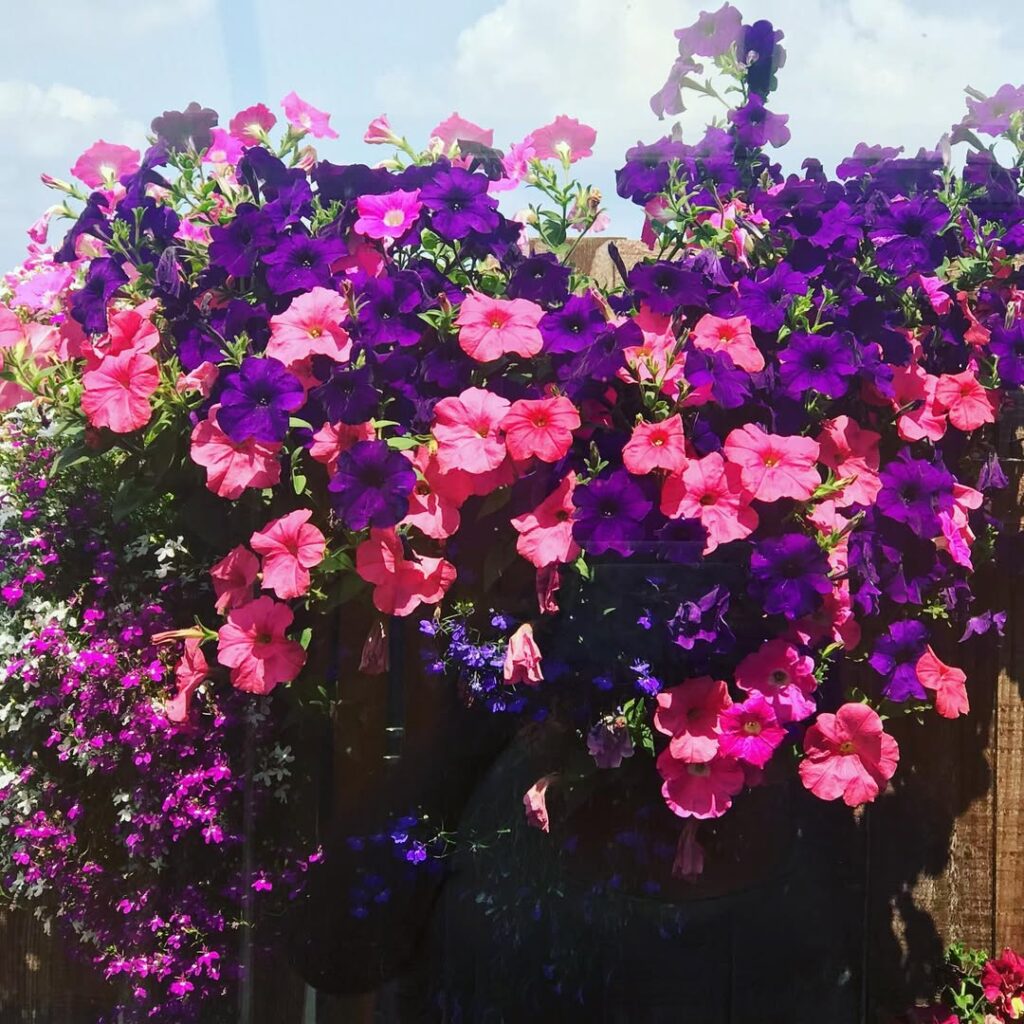
Petunias are popular annual flowers known for their trumpet-shaped blooms and sweet fragrance, especially noticeable in the evening hours. These versatile plants come in a wide range of colors including purple, pink, white, red, and bicolor varieties, making them excellent choices for containers, hanging baskets, and garden borders. Many varieties feature ruffled or double petals, and the plants typically grow 6-24 inches tall while spreading 12-36 inches wide, creating waves of continuous blooms from spring through fall.
- Light: Full sun (6-8 hours daily); can tolerate partial shade but may produce fewer blooms
- Water: Moderate watering; soil should be kept consistently moist but not waterlogged
- Soil: Well-draining, fertile soil with pH between 6.0-7.0
- Temperature: Thrives in 60-75°F (15-24°C)
- Fertilizer: Monthly feeding with balanced, water-soluble fertilizer
- Spacing: 12 inches between plants
- Maintenance: Regular deadheading to promote continuous blooming
- Planting Time: After last frost in spring
- Hardiness: Frost-sensitive annuals in most regions
5. Sunflowers
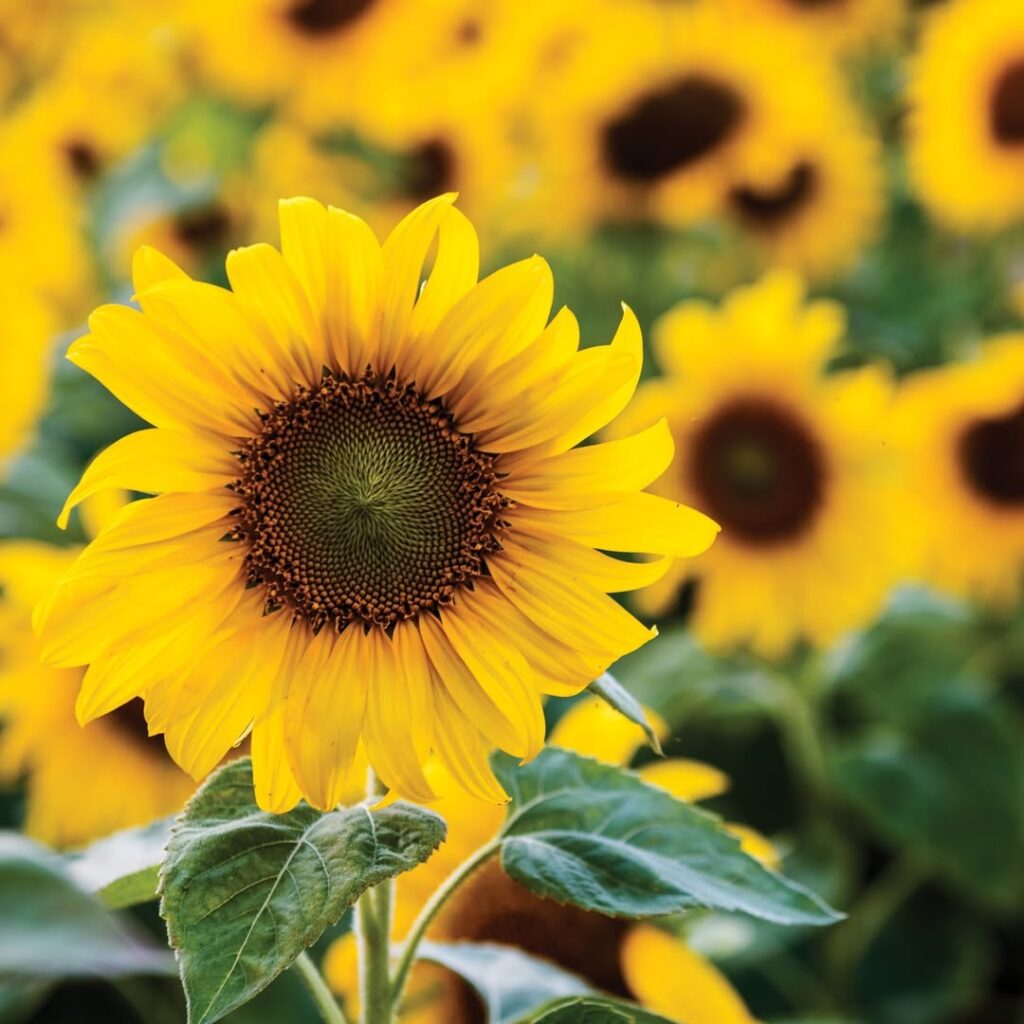
Sunflowers are iconic summer blooms that bring height and vibrant color to gardens with their large, daisy-like flower heads that can reach up to 12 inches across. These annual plants range from dwarf varieties of 2-3 feet to towering giants that can grow over 12 feet tall, all featuring distinctive yellow petals surrounding a dark center disk where seeds develop. Sunflowers track the sun’s movement throughout the day, a behavior known as heliotropism, and their cheerful appearance makes them popular choices for garden borders, cutting gardens, and children’s gardens.
- Light: Full sun (6-8 hours daily)
- Water: Moderate watering; about 1 inch per week; more during flowering and dry spells
- Soil: Well-draining, fertile soil with pH 6.0-7.5
- Temperature: 70-78°F for ideal growth
- Spacing: 6 inches apart for smaller varieties; 2-3 feet for larger types
- Planting Time: Spring, after last frost
- Fertilizer: Light feeding with balanced fertilizer; avoid excess nitrogen
- Depth: Plant seeds 1-2 inches deep
- Support: Stake tall varieties to prevent wind damage
6. Morning Glories

Blue morning glories are classic climbing flowering vines that reliably produce vibrant, trumpet-shaped blooms in shades of blue and purple. These fast-growing annual plants open their flowers in the early morning hours and close them by afternoon, creating a daily display that can cover trellises, fences, and arbors throughout the summer and fall growing seasons. While considered invasive in some regions, their vigorous growth and abundant flowering make them an excellent choice for beginner gardeners looking to create vertical interest in their gardens.
- Light: Full sun, minimum 6 hours daily
- Water: Regular watering to maintain consistently moist soil, not waterlogged
- Soil: Well-draining, moderately fertile soil with pH 6.0-6.8
- Temperature: 65-85°F (18-29°C)
- Spacing: 6-12 inches apart
- Support: Requires trellis, fence, or other climbing structure
- Planting Time: After last frost in spring
- Soil Depth: Seeds 1/4 inch deep
- Fertilizer: Light feeding with balanced fertilizer monthly
- Pruning: Remove spent blooms to encourage continued flowering
7. Black-Eyed Susans
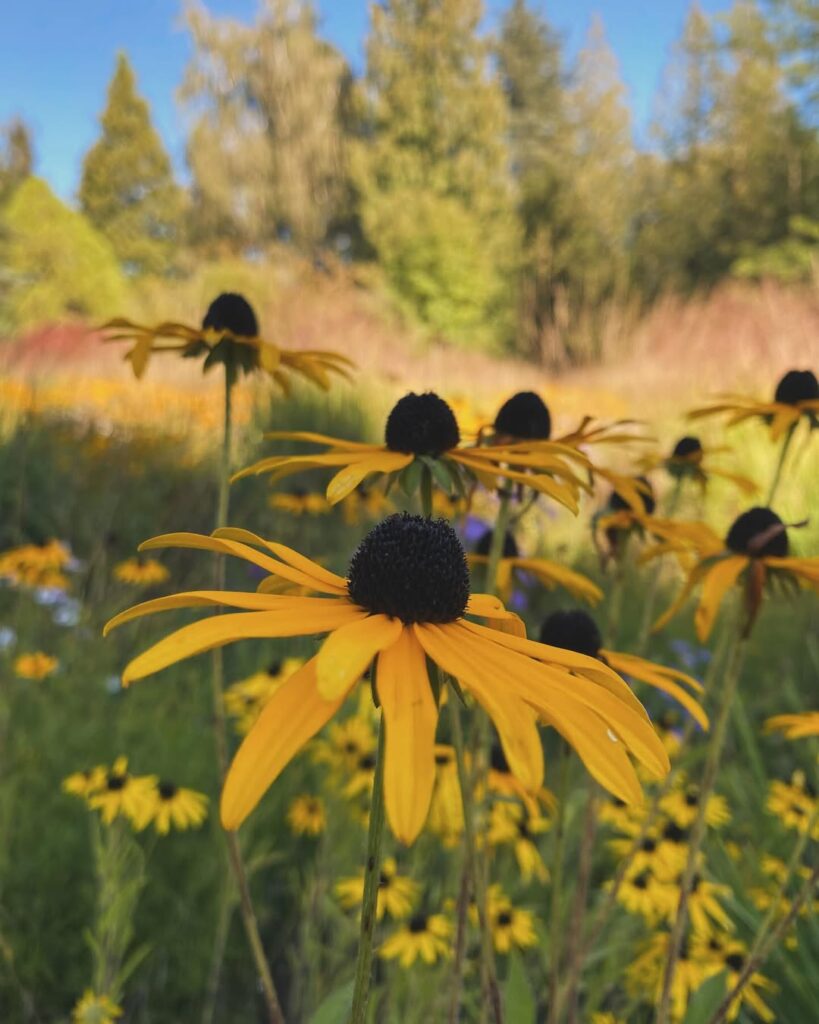
Black-Eyed Susans (Rudbeckia hirta) are cheerful, daisy-like flowers that bloom abundantly from summer through fall, featuring golden-yellow petals surrounding dark brown centers. These hardy perennials are perfect for novice gardeners due to their resilient nature, drought tolerance, and ability to thrive with minimal care. They grow in dense clusters reaching heights of 2-3 feet, making them excellent choices for borders, meadow gardens, and cut flower arrangements.
- Light: Full sun; tolerates partial shade but blooms best with 6-8 hours of direct sunlight daily
- Water: Moderate watering; drought-tolerant once established; water deeply once per week in dry conditions
- Soil: Well-draining, average soil; adapts to various soil types including clay
- Temperature: Hardy in USDA zones 3-9
- Spacing: 18-24 inches between plants
- Fertilizer: Light feeder; minimal fertilization needed; one application of all-purpose fertilizer in spring
- pH Level: 6.0-7.0, but tolerates slightly acidic to slightly alkaline conditions
8. Lantanas
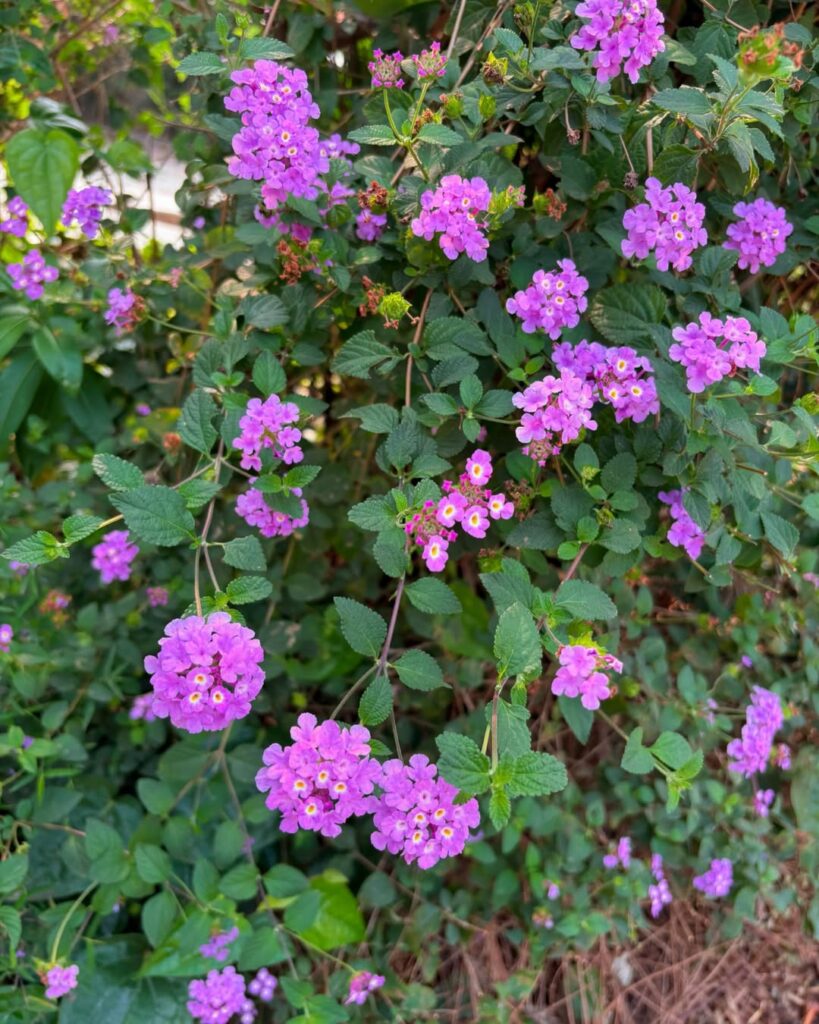
Purple Lantanas are hardy, drought-resistant flowering plants that produce clusters of small, tubular blooms in vibrant purple shades. These low-maintenance perennials spread vigorously and can bloom continuously from spring through fall, making them excellent choices for borders, containers, or as ground cover. Their aromatic foliage and prolific flowering habits attract butterflies and hummingbirds, while their tough nature helps them withstand challenging conditions with minimal care.
- Light: Full sun; at least 6-8 hours of direct sunlight daily
- Water: Low to moderate; water deeply but infrequently once established
- Soil: Well-draining, slightly acidic to neutral pH (6.0-7.0)
- Temperature: Thrives in warm climates; hardy in USDA zones 8-11
- Spacing: 2-4 feet apart to allow for spread
- Fertilizer: Light feeding in spring with balanced fertilizer
- Pruning: Cut back by one-third in late winter to encourage bushier growth
9. Pansies
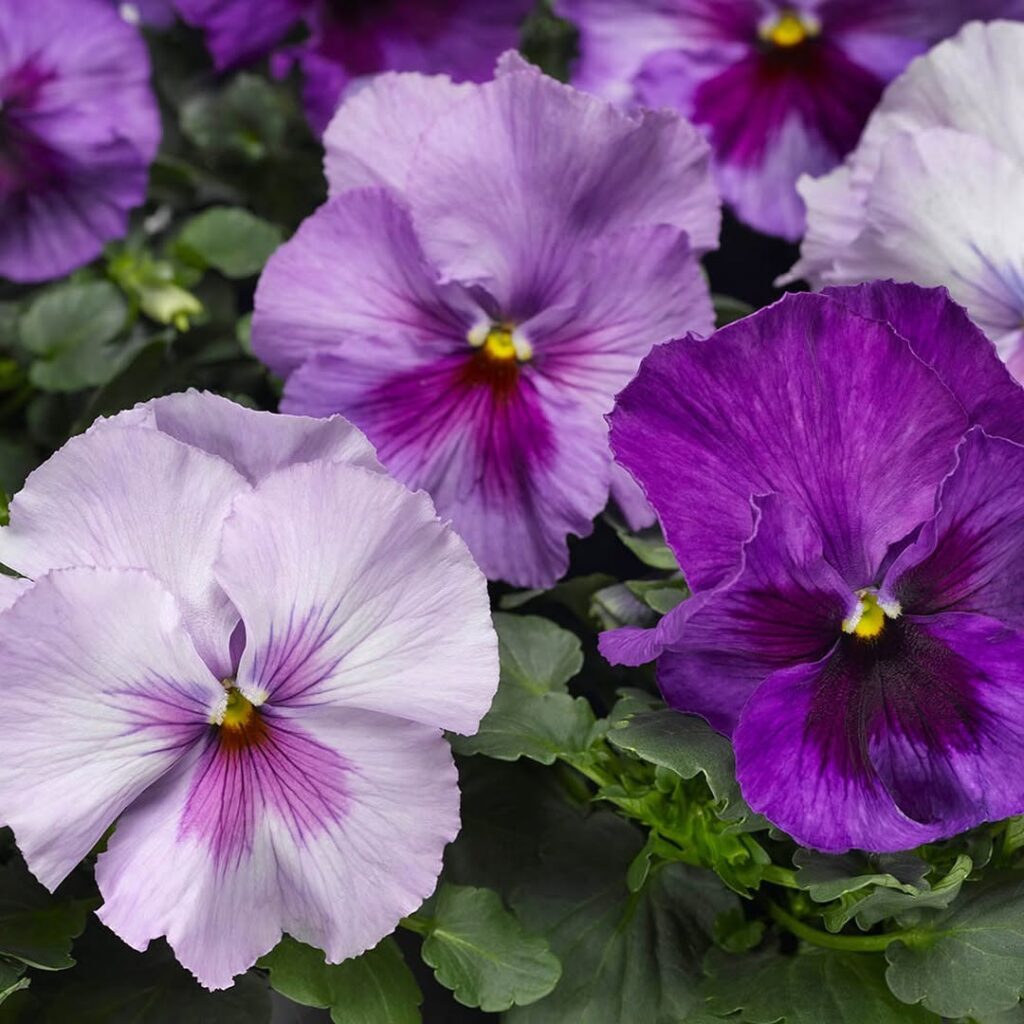
Pansies are cheerful, low-growing annual flowers that feature delicate petals in a wide range of colors, including purple, yellow, white, red, and bi-colored varieties. With their distinctive “face-like” markings, these compact plants typically grow 6-9 inches tall and bloom prolifically from early spring through early summer. Pansies are popular choices for borders, containers, and mass plantings, offering reliable color during cooler seasons when many other flowers struggle.
- Light: Full sun to partial shade; protect from intense afternoon sun in warmer climates
- Water: Keep soil consistently moist but not waterlogged; water when top inch of soil feels dry
- Soil: Well-draining, rich organic soil with pH between 5.4 and 5.8
- Temperature: Prefer cool conditions; ideal growing temps between 40-65°F
- Fertilizer: Light feeding every 2-3 weeks with balanced, water-soluble fertilizer
- Spacing: Plant 6-8 inches apart to allow proper air circulation
- Maintenance: Remove spent blooms regularly to encourage continuous flowering
10. Geraniums
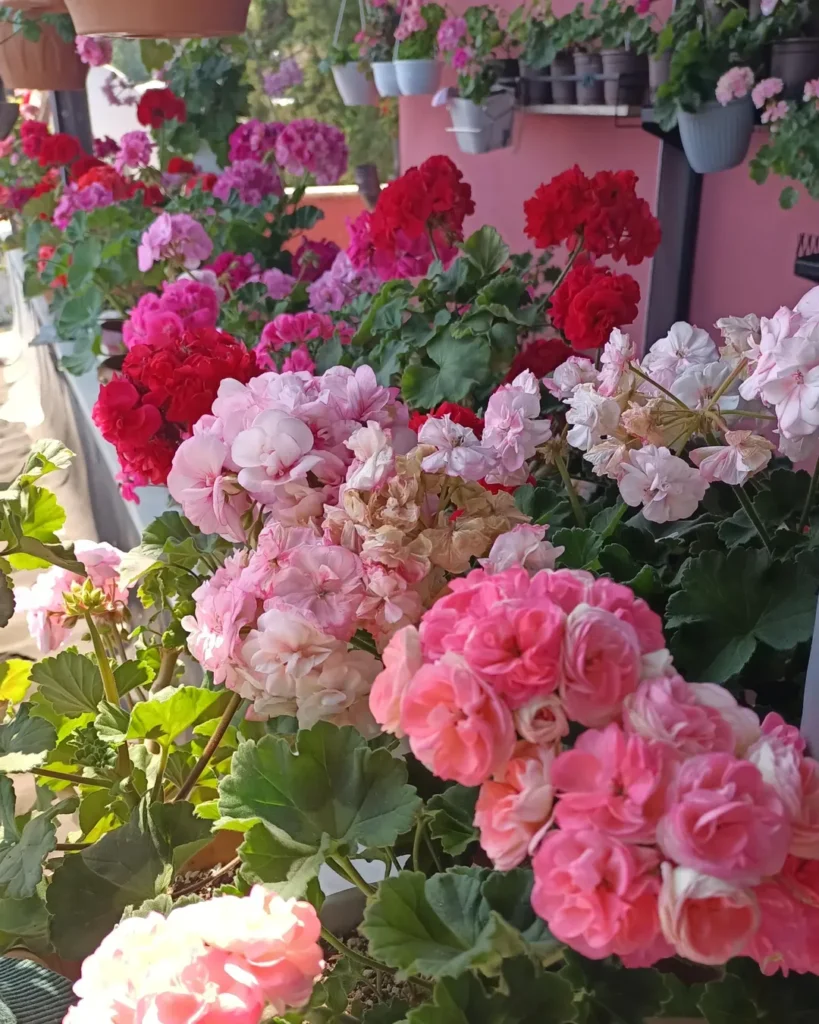
Hardy pink geraniums are robust perennial flowers that produce clusters of vibrant pink blooms from late spring through fall. These easy-to-grow plants feature rounded, sometimes scalloped leaves and can spread up to 24 inches wide, making them excellent ground covers or border plants. Their long-lasting flowers attract butterflies and create cheerful garden displays while requiring minimal maintenance, making them perfect for beginner gardeners.
- Light: Prefers full sun to partial shade; best flowering occurs with 6-8 hours of direct sunlight daily
- Water: Medium moisture; water when top inch of soil feels dry; avoid overwatering
- Soil: Well-draining, fertile soil with pH 6.0-7.0
- Temperature: Hardy in zones 4-9; tolerates heat well
- Spacing: Plant 12-24 inches apart
- Fertilizer: Light feeding in spring with balanced fertilizer
- Maintenance: Deadhead spent blooms to encourage continuous flowering
- Winter Care: Cut back foliage in late fall; add mulch in cold regions
11. Impatiens

Pink Impatiens are popular shade-loving annuals that produce abundant delicate blooms throughout the growing season. These compact plants feature soft, oval-shaped leaves and produce clusters of five-petaled flowers in various shades of pink, from pale ballet pink to deep rose. Perfect for borders, containers, and hanging baskets, impatiens provide reliable color in shady garden spots where many other flowering plants struggle to thrive.
- Light: Thrives in full to partial shade; morning sun is acceptable but avoid hot afternoon exposure
- Water: Requires consistently moist soil; water deeply when top inch of soil feels dry
- Soil: Well-draining, rich organic soil with pH between 6.0 and 6.5
- Temperature: Prefers temperatures between 65-75°F (18-24°C)
- Spacing: Plant 8-12 inches apart
- Fertilizer: Feed every 2-3 weeks during growing season with balanced, water-soluble fertilizer
- Humidity: Enjoys high humidity levels
- Winter hardiness: Not frost tolerant; grow as annual in most regions
12. Echinacea
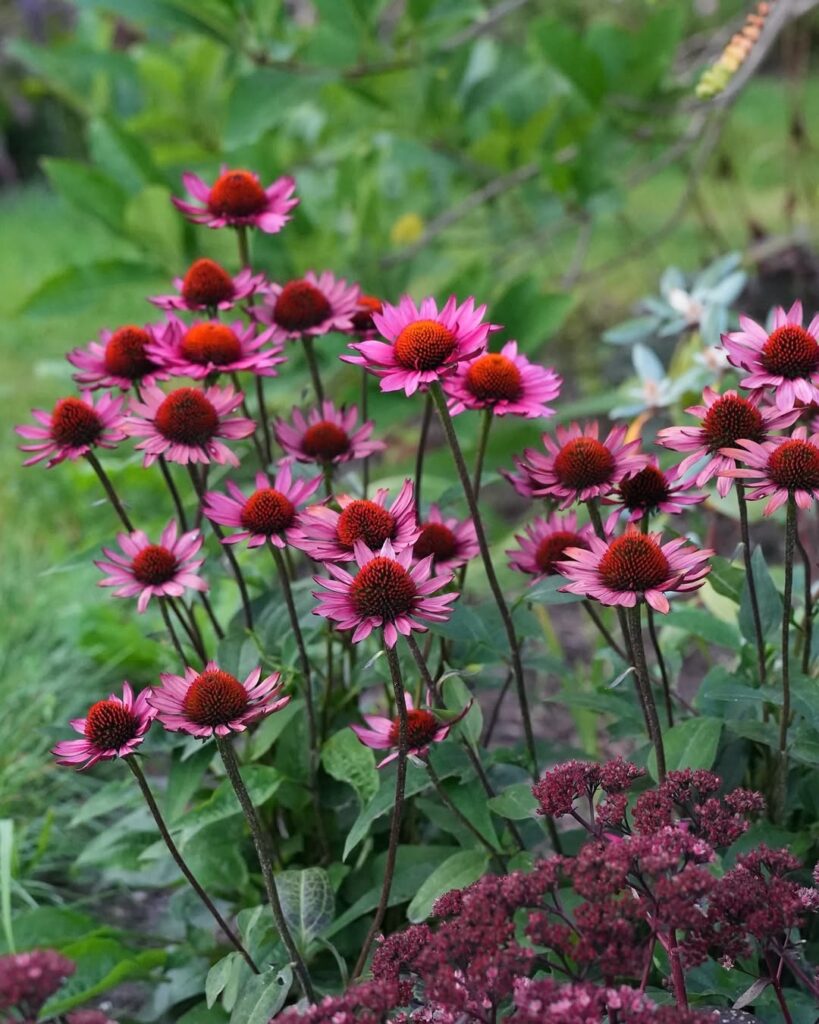
Echinacea, commonly known as coneflower, is a drought-resistant perennial that produces large, daisy-like blooms with raised central cones. These hardy plants feature sturdy stems and distinctive purple, pink, or white petals that attract pollinators throughout summer and fall. Their deep root system enables them to withstand extended dry periods while maintaining their vibrant blooms, making them an excellent choice for beginners and water-conscious gardeners.
- Light: Full sun to partial shade, minimum 6 hours of direct sunlight daily
- Water: Low to moderate; water deeply but infrequently once established
- Soil: Well-draining, average to poor soil; tolerates clay or sandy conditions
- pH: 6.0-7.0
- Temperature: Hardy in zones 3-9
- Spacing: 18-24 inches apart
- Fertilizer: Light feeder; minimal fertilization needed
- Height: 2-4 feet tall at maturity
13. Dianthus

Pink Dianthus, also known as “pinks,” are charming perennial flowers that provide extended blooming periods from late spring through early fall. These low-growing plants form neat mounds of blue-green foliage topped with delicate, fringed flowers in various shades of pink. The blooms emit a sweet, spicy fragrance similar to cloves, making them excellent choices for borders, rock gardens, and container plantings. With proper deadheading, these hardy plants will continue producing fresh waves of flowers throughout the growing season.
- Light: Full sun to partial shade; at least 6 hours of direct sunlight daily for best blooming
- Water: Medium moisture; water when top inch of soil feels dry; drought tolerant once established
- Soil: Well-draining, slightly alkaline soil with pH 6.5-7.5
- Temperature: Hardy in zones 3-9; tolerates both heat and cold
- Spacing: Plant 6-12 inches apart
- Fertilizer: Light feeding in spring with balanced fertilizer
- Maintenance: Remove spent blooms regularly to encourage continued flowering
- Drainage: Requires excellent drainage to prevent root rot
- Air circulation: Good air flow between plants to prevent fungal issues
- Winter care: Add light mulch in cold regions for winter protection
14. Easy Purple Annual Angelonia
Angelonia, often called summer snapdragon, is a low-maintenance annual that produces elegant spikes of purple blooms throughout the growing season. These upright plants typically reach 12-18 inches in height and feature small, delicate flowers arranged vertically along sturdy stems. The purple variety offers reliable color from late spring through fall, making it an excellent choice for borders, containers, and cutting gardens. Its heat tolerance and continuous blooming habit make it particularly appealing to novice gardeners.
- Light: Full sun to partial shade; performs best with 6-8 hours of direct sunlight daily
- Water: Medium moisture; water when top inch of soil feels dry
- Soil: Well-draining, fertile soil with pH 6.0-7.0
- Temperature: Thrives in warm weather; ideal range 65-85°F
- Spacing: Plant 12-15 inches apart
- Fertilizer: Monthly feeding with balanced, water-soluble fertilizer
- Maintenance: Deadhead spent blooms to encourage continued flowering
- Hardiness: Annual in most zones; may overwinter in zones 9-11
15. Red Jasmine
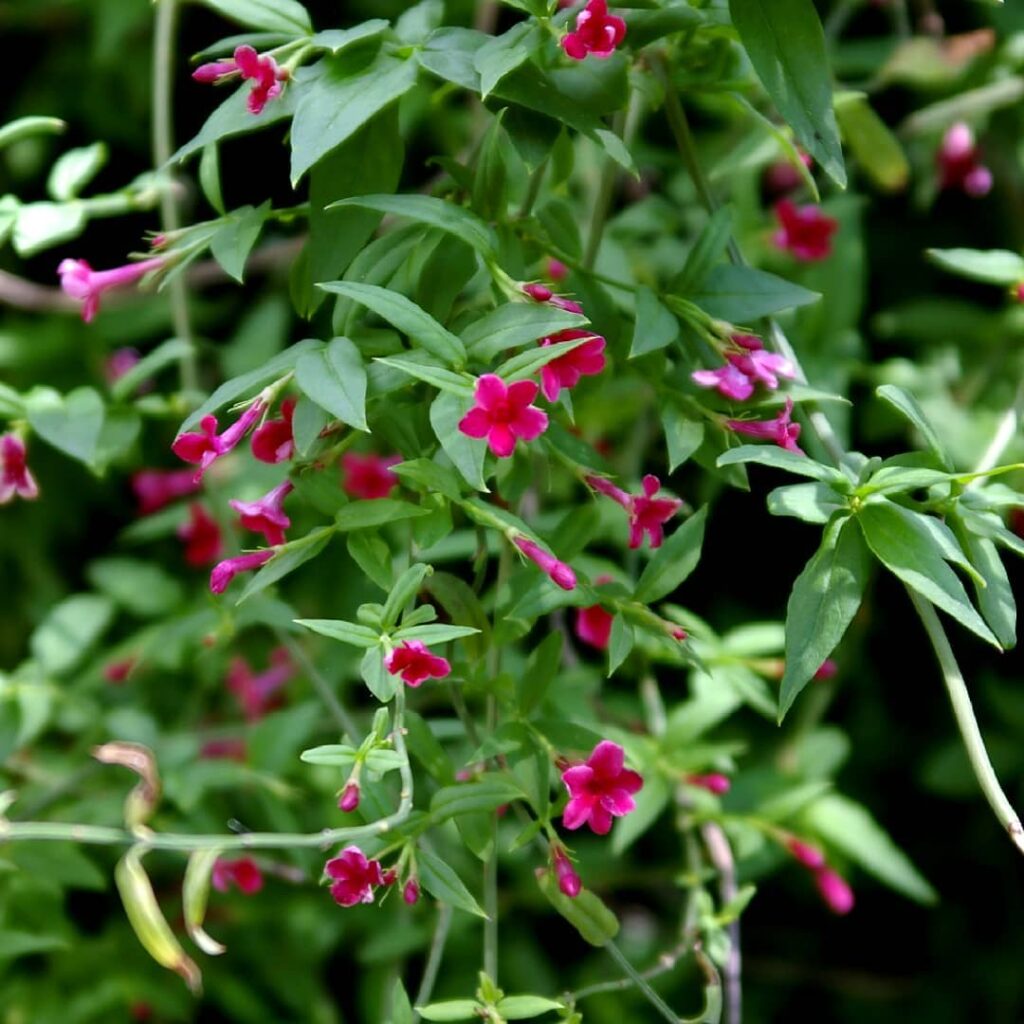
Climbing red Jasmine (Jasminum beesianum) is a vigorous evergreen vine known for its deep red, star-shaped flowers that emit a sweet fragrance. This Chinese native can grow up to 15 feet tall and produces clusters of small blooms from late spring through summer. Its slender stems feature dark green leaves, making it an attractive option for trellises, arbors, and fences, while its compact growing habit makes it suitable for container gardening as well.
- Light: Full sun to partial shade; best flowering occurs in full sun
- Water: Regular watering; keep soil consistently moist but not waterlogged
- Soil: Well-draining, rich, slightly acidic soil (pH 6.0-7.0)
- Temperature: Hardy in zones 7-10; prefers temperatures between 60-75°F
- Humidity: Moderate to high humidity levels
- Fertilizer: Monthly feeding during growing season with balanced fertilizer
- Support: Requires sturdy trellis or support structure for climbing
- Pruning: Light pruning after flowering to maintain shape and remove dead growth
